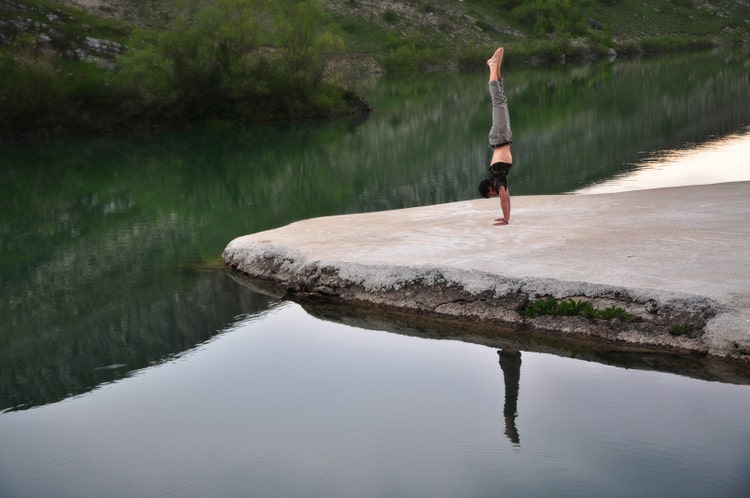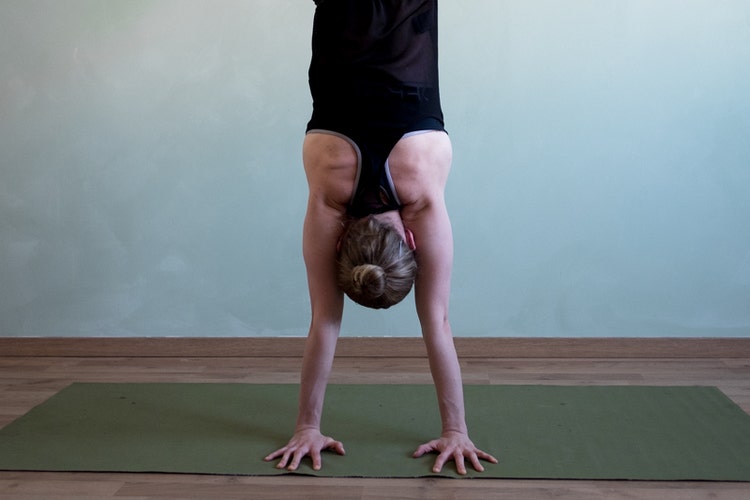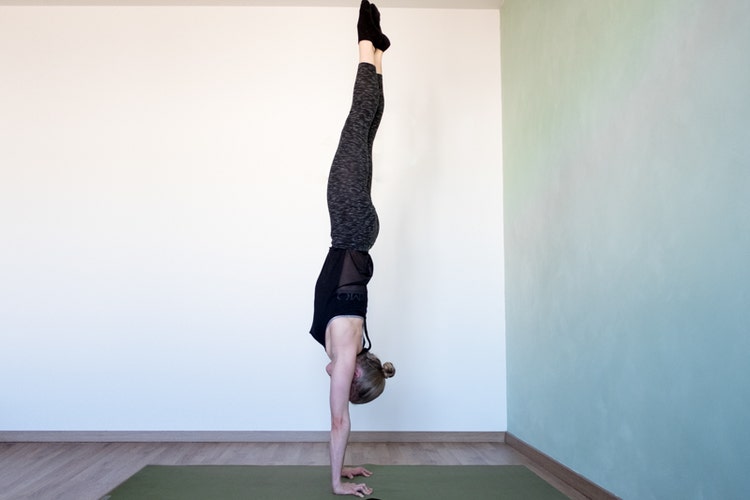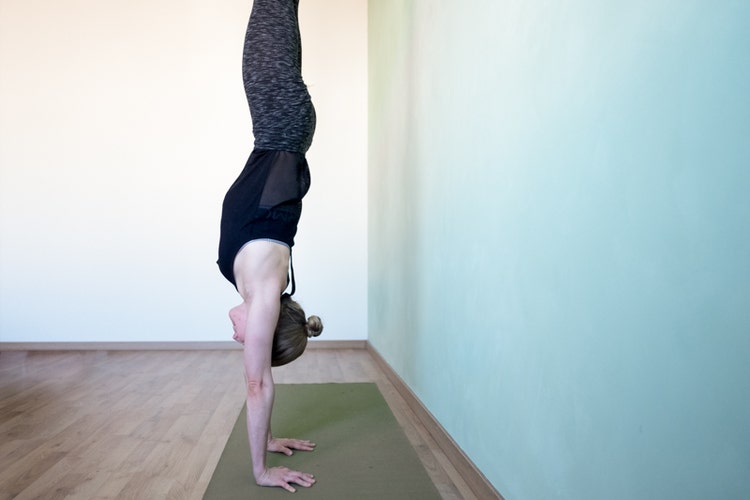How to Get Your First Handstand

Handstands and other hand balancing exercises are impressive skills that demonstrate a high level of strength and control. Training for a handstand helps build strength in the shoulders, wrists, and really, throughout the body (if you’re doing it correctly).
If you’ve always wanted to learn to do a handstand, or even if you’d just like to improve your current level of skill, this tutorial will give you the tools you need to get going.
Body positioning
Body position is everything when it comes to the handstand. It can mean the difference between a beautiful line and toppling over.
If you understand where every part of your body should be in the handstand, it will be much easier to make sure your center of gravity is directly over your hands – which is the key to staying upright with less effort.
Hand position
The hands should be shoulder width apart, with the fingers splayed wide.
- One of the biggest mistakes I see with my students is a tendency to keep the fingers fairly close together, which creates a narrower base and makes it much more difficult to balance.
- We want to maximize the support we can get from our hands, making sure to press the palms firmly into the floor.
Elbow position
- The elbows should be screwed inward, so that the inside of your elbow (the “elbow pit”) is facing forward. You may not be able to do this right away or you may have trouble maintaining this position, but the most important thing is the intent and the action.
- This helps you to keep your elbows as straight as possible – bent elbows mean more muscle work and earlier fatigue – and helps get the shoulders into the proper position as well.

Shoulder position
- The ideal position for the shoulders in the straight line handstand is for them to be fully elevated and hugging your ears.
- Once you start practicing handstands and paying attention to the little details, you’ll see how the elbow position is integral to getting the shoulders into the right position too. If you flare your elbows out, your shoulder blades will want to come together, when they should be lifted up towards your ears.

Handstand head position
- Proper head position is an important part of getting your balance and improving your line.
- When you’re first practicing handstands, you may not want to worry too much about the head position, as it’s more important to get comfortable with being upside down, but eventually you will want to play around with how your head position affects your handstand practice.

Bailing out of the handstand
When working on handstands, one of the most important things to learn is how to safely bail out of the handstand. Especially in the beginning, you’re going to fall – a lot. And that’s okay. As long as you know how to do so properly, you’ll be fine.
To bail out of the handstand when you feel like you’re going to fall, I recommend using a cartwheel motion, where you scissor your legs to drop one to the ground to catch yourself. That way, you land on your feet, rather than on your head.
https://www.youtube.com/watch?v=UO8i8CUlwek
Handstand practice
Warm-ups
Warming up and preparing your body to do a handstand is very important, both to prevent any problems and also to attain the best form and positioning possible
Shoulder circles forward and backward
- Extend your hands up and away from you as much as you can as you make circles forward and then backward.
Shoulder cross arms
- Swing your arms in front of you so that you pull your arms into your chest like you are giving yourself a hug.
Shoulder/chest opening
- Swing your arms to the side and stick your chest up and out in front of you.
Wrist stretch fingers facing forward
- On your hands and knees with your hands shoulder width apart and fingers facing forward, rock forward to stretch your wrists.
Wrist stretch fingers facing backward
- On your hands and knees with your hands shoulder width apart and fingers facing backward rock towards your feet to stretch your wrists.
https://www.youtube.com/watch?v=BSWWL1DOUM4
Exercises
The following are the best progressions to get you working up to a full handstand, beginning with the first step of getting upside down comfortably by using various step-by-step exercises that will eventually lead up to moving away from the wall.
Wall walk-up
- Place your hands on the ground so that you can get both feet up on the wall.
- Walk your hands in until they are just a couple inches away from the wall.
- Lock your knees out straight and flex your ankles to 90 degrees so that your toes or balls of your feet are touching the wall.
https://www.youtube.com/watch?v=9hxJt85PnHQ
Kick up on wall
- Now you will turn the other direction placing your hands close to the wall, with your fingers facing the wall.
- Pressing into the ground, kick one leg up towards the wall, letting your other leg follow.
- This will take some practice – don’t be frustrated if you don’t get the kick up right away! Just be patient and keep practicing, and you’ll get it!
- Once you’re up on the wall, push your hands firmly into the ground, extend the shoulders, and make sure all the other body positioning cues are in place.
https://www.youtube.com/watch?v=ownvhG3glGg
Float from the wall
- This is a continuation from the last progression but it’s an important step before moving off the wall.
- Once you’re comfortable with the kick-up against the wall, work on your body positioning and on pushing through your hands as strongly as possible.
- Rather than pulling your feet off the wall, let them float off the wall by pressing firmly into the ground and extending through the shoulders.
https://www.youtube.com/watch?v=hcY2FAyS9q4
Freestanding handstand
- For the kick-up, don’t overkick – err on the side of underkicking at first.
- Work on kicking one leg up. Don’t even worry about the other leg.
- Eventually you’ll be able to kick the leading leg higher, and you’ll find your bottom leg will follow.
- Practice bringing the feet together to meet each other.
- Once you can get some balance work on the same positioning you’ve been working on all along.
https://www.youtube.com/watch?v=b1zX4VZDHC4
Daily handstand program
Here’s a daily schedule you can follow here using all the concepts and exercises we’ve shown you:
Day 1
- Shoulder and Wrist Warm-Up – 3 sets of 10 reps
- Practice Bailing Out – 3 sets of 5 reps
- Wall Walk Up – 3 sets of 30 seconds (use a timer or app)
- Kick up on Wall – 3 sets of 30 seconds (focus on your hand and shoulder position)
Day 2
- Shoulder and Wrist Warm-Up – 3 sets of 10 reps
- Practice Bailing Out – 3 sets of 5 reps
- Wall Walk Up – 4 sets of 30 seconds (use a timer or app)
- Kick up on Wall – 4 sets of 30 seconds (focus on your hand and shoulder position)
Day 3
- Shoulder and Wrist Warm-Up – 3 sets of 10 reps
- Practice Bailing Out – 3 sets of 5 reps
- Wall Walk Up – 2 sets of 30 seconds (use a timer or app)
- Kick up on Wall – 3 sets of 30 seconds
- Float from the Wall – 3 sets of 15 seconds (focus on the “push through the ground”)
Day 4
- Shoulder and Wrist Warm-Up – 3 sets of 10 reps
- Practice Bailing Out – 3 sets of 5 reps
- Wall Walk Up – 2 sets of 30 seconds (use a timer or app)
- Kick up on Wall – 2 sets of 30 seconds
- Float from the Wall – 4 sets of 15 seconds (focus on the “push through the ground”)
Day 5
- Shoulder and Wrist Warm-Up- 3 sets of 10 reps
- Practice Bailing Out – 3 sets of 5 reps
- Wall Walk Up – 1 set of 30 seconds (use a timer or app)
- Kick up on Wall – 1 set of 30 seconds
- Float from the Wall – 5 sets of 15 seconds (focus on the “push through the ground”)
Day 6
- Shoulder and Wrist Warm-Up – 3 sets of 10 reps
- Practice Bailing Out – 3 sets of 5 reps
- Wall Walk Up – 1 set of 30 seconds (use a timer or app)
- Kick up on Wall – 1 set of 30 seconds
- Float from the Wall – 5 sets of 15 seconds (focus on the “push through the ground”)
- Freestanding Handstand – 3 sets of 15 seconds (focus on the “push through the ground”)
Day 7
- Shoulder and Wrist Warm-Up – 3 sets of 10 reps
- Practice Bailing Out – 3 sets of 5 reps
- Wall Walk Up – 1 set of 30 seconds (use a timer or app)
- Kick up on Wall – 1 set of 30 seconds
- Float from the Wall – 3 sets of 15 seconds (focus on the “push through the ground”)
- Freestanding Handstand – 4 sets of 15 seconds (focus on the “push through the ground”)
Use this daily program as a guide, and with dedicated practice you’ll nail that handstand!
Photo credit: thinkstock, iStock, pemblton.